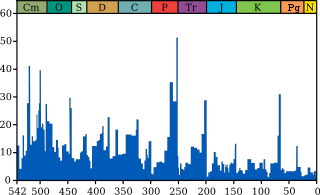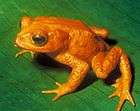List of extinction events
This is a list of extinction events, both mass and minor:[1]
Major extinction events (see graphic)
Timeline
References
- Partial list from Image:Extinction Intensity.png
- Bond, David P. G.; Grasby, Stephen E. (2017-07-15). "On the causes of mass extinctions". Palaeogeography, Palaeoclimatology, Palaeoecology. Mass Extinction Causality: Records of Anoxia, Acidification, and Global Warming during Earth's Greatest Crises. 478: 3–29. doi:10.1016/j.palaeo.2016.11.005. ISSN 0031-0182.
- Ripple WJ, Wolf C, Newsome TM, Galetti M, Alamgir M, Crist E, Mahmoud MI, Laurance WF (13 November 2017). "World Scientists' Warning to Humanity: A Second Notice". BioScience. 67 (12): 1026–1028. doi:10.1093/biosci/bix125.
Moreover, we have unleashed a mass extinction event, the sixth in roughly 540 million years, wherein many current life forms could be annihilated or at least committed to extinction by the end of this century.
- Sandom, Christopher; Faurby, Søren; Sandel, Brody; Svenning, Jens-Christian (4 June 2014). "Global late Quaternary megafauna extinctions linked to humans, not climate change". Proceedings of the Royal Society B. 281 (1787): 20133254. doi:10.1098/rspb.2013.3254. PMC 4071532. PMID 24898370.
- Vignieri, S. (25 July 2014). "Vanishing fauna (Special issue)". Science. 345 (6195): 392–412. Bibcode:2014Sci...345..392V. doi:10.1126/science.345.6195.392. PMID 25061199.
Although some debate persists, most of the evidence suggests that humans were responsible for extinction of this Pleistocene fauna, and we continue to drive animal extinctions today through the destruction of wild lands, consumption of animals as a resource or a luxury, and persecution of species we see as threats or competitors.
- Benitez, Narciso; et al. (2002). "Evidence for Nearby Supernova Explosions". Phys. Rev. Lett. 88 (8): 081101. arXiv:astro-ph/0201018. Bibcode:2002PhRvL..88h1101B. doi:10.1103/PhysRevLett.88.081101. PMID 11863949.
- Fimiani, L.; Cook, D.L.; Faestermann, T.; Gómez-Guzmán, J.M.; Hain, K.; Herzog, G.; Knie, K.; Korschinek, G.; Ludwig, P.; Park, J.; Reedy, R.C.; Rugel, G. (13 April 2016). "Interstellar 60Fe on the Surface of the Moon". Physical Review Letters. 116 (15): 151104. Bibcode:2016PhRvL.116o1104F. doi:10.1103/PhysRevLett.116.151104. PMID 27127953.
- "Pliocene-Pleistocene boundary: did Eltanin asteroid kickstart the ice ages?". Archived from the original on 2017-10-03. Retrieved 2019-01-18.
- "Did a Killer Asteroid Drive the Planet Into An Ice Age?". Universe Today. 20 September 2012.
- Holbourn, Ann; Kuhnt, Wolfgang; Schulz, Michael; Erlenkeuser, Helmut (2005). "Impacts of orbital forcing and atmospheric carbon dioxide on Miocene ice-sheet expansion". Nature. 438 (7067): 483–87. Bibcode:2005Natur.438..483H. doi:10.1038/nature04123. PMID 16306989.
- "Russia's Popigai Meteor Crash Linked to Mass Extinction". June 13, 2014.
- Randall, Lisa (2015). Dark Matter and the Dinosaurs. New York: Ecco/HarperCollins Publishers. pp. 196–217. ISBN 978-0-06-232847-2.
- Keller G. (2012). "The Cretaceous–Tertiary Mass Extinction, Chicxulub Impact, and Deccan Volcanism. Earth and Life". In Talent JA (ed.). Earth and Life: Global Biodiversity, Extinction Intervals and Biogeographic Perturbations Through Time. Springer. pp. 759–93. ISBN 978-9048134274.
- David Bond; Paul Wignall. "Large igneous provinces and mass extinctions: An update" (PDF). p. 17. Archived from the original (PDF) on 2016-01-24.
- Singh, A. P.; Kumar, Niraj; Singh, Bijendra (2004). Magmatic underplating beneath the Rajmahal Traps:Gravity signature and derived 3-D configuration.Proc. pp. 759–769. CiteSeerX 10.1.1.501.4945.
- Tennant, Jonathan P.; Mannion, Philip D.; Upchurch, Paul; Sutton, Mark D.; Price, Gregory D. (2017). "Biotic and environmental dynamics through the Late Jurassic–Early Cretaceous transition: evidence for protracted faunal and ecological turnover". Biological Reviews. 92 (2): 776–814. doi:10.1111/brv.12255. ISSN 1469-185X. PMID 26888552.
- József Pálfy; Paul L. Smith (2000). "Synchrony between Early Jurassic extinction, oceanic anoxic event, and the Karoo-Ferrar flood basalt volcanism". Geology. 28 (8): 747–750. doi:10.1130/0091-7613(2000)28<747:SBEJEO>2.0.CO;2.
- Blackburn, Terrence J.; Olsen, Paul E.; Bowring, Samuel A.; McLean, Noah M.; Kent, Dennis V; Puffer, John; McHone, Greg; Rasbury, Troy; Et-Touhami7, Mohammed (2013). "Zircon U-Pb Geochronology Links the End-Triassic Extinction with the Central Atlantic Magmatic Province". Science. 340 (6135): 941–45. Bibcode:2013Sci...340..941B. CiteSeerX 10.1.1.1019.4042. doi:10.1126/science.1234204. PMID 23519213.
- Onoue, Tetsuji; Sato, Honami; Yamashita, Daisuke; Ikehara, Minoru; Yasukawa, Kazutaka; Fujinaga, Koichiro; Kato, Yasuhiro; Matsuoka, Atsushi (8 July 2016). "Bolide impact triggered the Late Triassic extinction event in equatorial Panthalassa". Scientific Reports. 6 (29609): 1–8. Bibcode:2016NatSR...629609O. doi:10.1038/srep29609. PMC 4937377. PMID 27387863.
- Dal Corso, J.; Mietto, P.; Newton, R.J.; Pancost, R.D.; Preto, N.; Roghi, G.; Wignall, P.B. (2012). "Discovery of a major negative δ13C spike in the Carnian (Late Triassic) linked to the eruption of Wrangellia flood basalts". Geology. 40 (1): 79–82. Bibcode:2012Geo....40...79D. doi:10.1130/g32473.1.
- Campbell, I; Czamanske, G.; Fedorenko, V.; Hill, R.; Stepanov, V. (1992). "Synchronism of the Siberian Traps and the Permian-Triassic Boundary". Science. 258 (5089): 1760–63. Bibcode:1992Sci...258.1760C. doi:10.1126/science.258.5089.1760. PMID 17831657.
- von Frese, R; Potts, L.; Wells, S.; Leftwich, T.; Kim, H. (2009). "GRACE gravity evidence for an impact basin in Wilkes Land, Antarctica". Geochemistry, Geophysics, Geosystems. 10 (2): n/a. Bibcode:2009GGG....10.2014V. doi:10.1029/2008GC002149.
- Wignall, P; Twitchett, R (2002). "Extent, duration, and nature of the Permian-Triassic superanoxic event". In Christian Koeberl; Kenneth G. MacLeod (eds.). Catastrophic events and mass extinctions: impacts and beyond. Geological Society of America. p. 396. doi:10.1130/0-8137-2356-6.395. ISBN 978-0813723563.
- Ice age, not warming, explains Permian-Triassic extinction event - UPI.com
- Bond, David P.G.; Wignall, Paul B. (2014-09-01). "Large igneous provinces and mass extinctions: An update". Geological Society of America Special Papers. 505: 29–55. doi:10.1130/2014.2505(02). ISBN 9780813725055. ISSN 0072-1077.
- Doblas, Miguel; R., OYARZUN; J., LOPEZ-RUIZ; J.M., CEBRIA; Youbi, Nasrrddine; V., MAHECHA; Lago San José, Marceliano; POCOVI; B., CABANIS (1998-12-01). "Permo-Carboniferous Volcanism in Europe and North Africa: a Superplume exhaust valve in The Center of Pangea". Journal of African Earth Sciences. 26: 89–99. doi:10.1016/S0899-5362(97)00138-3.
- Ricci, J; et al. (2013). "New 40Ar/39Ar and K–Ar ages of the Viluy traps (Eastern Siberia): Further evidence for a relationship with the Frasnian–Famennian mass extinction". Palaeogeography, Palaeoclimatology, Palaeoecology. 386: 531–40. doi:10.1016/j.palaeo.2013.06.020.
- Jeppsson, L. (1998). "Silurian oceanic events: summary of general characteristics". In Landing, E.; Johnson, M.E. (eds.). Silurian Cycles: Linkages of Dynamic Stratigraphy with Atmospheric, Oceanic and Tectonic Changes. James Hall Centennial Volume. New York State Museum Bulletin. 491. pp. 239–57.
- Jeppsson, L.; Calner, M. (2007). "The Silurian Mulde Event and a scenario for secundo – secundo events". Earth and Environmental Science Transactions of the Royal Society of Edinburgh. 93 (2): 135–54. doi:10.1017/s0263593300000377.
- Munnecke, Axel; Samtleben, Christian; Bickert, Torsten (5 June 2003). "The Ireviken Event in the lower Silurian of Gotland, Sweden - relation to similar Palaeozoic and Proterozoic events". Palaeogeography, Palaeoclimatology, Palaeoecology. 195 (1–2): 119. doi:10.1016/S0031-0182(03)00304-3.
- Jeppsson, L (1997). "The anatomy of the Mid-Early Silurian Ireviken Event and a scenario for P-S events". In Brett, C.E.; Baird, G.C. (eds.). Paleontological Events: Stratigraphic, Ecological, and Evolutionary Implications. New York: Columbia University Press. pp. 451–92.
- Melott, A.L.; et al. (2004). "Did a gamma-ray burst initiate the late Ordovician mass extinction?". International Journal of Astrobiology. 3 (1): 55–61. arXiv:astro-ph/0309415. Bibcode:2004IJAsB...3...55M. doi:10.1017/S1473550404001910.
- Ware, Bryant D.; Jourdan, Fred; Merle, Renaud; Chiaradia, Massimo; Hodges, Kyle (2018-04-01). "The Kalkarindji Large Igneous Province, Australia: Petrogenesis of the Oldest and Most Compositionally Homogenous Province of the Phanerozoic". Journal of Petrology. 59 (4): 635–665. doi:10.1093/petrology/egy040. ISSN 0022-3530.
- Extensive marine anoxia during the terminal Ediacaran Period - Science Advances
This article is issued from Wikipedia. The text is licensed under Creative Commons - Attribution - Sharealike. Additional terms may apply for the media files.

